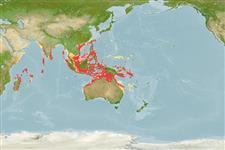Ikan bertulang rawan (sharks and rays) >
Myliobatiformes (Stingrays) >
Dasyatidae (Stingrays) > Urogymninae
Etymology: Urogymnus: Greek, oura = tail + Greek, gymnos = naked (Ref. 45335).
More on author: Macleay.
Environment: milieu / climate zone / depth range / distribution range
Ekologi
laut; payau berasosiasi dengan karang; kisaran kedalaman 1 - 85 m (Ref. 9840). Tropical; 26°N - 28°S, 44°E - 163°E
Indo-West Pacific: Red Sea to Oceania, distribution considered patchy but probably widespread.
Size / Weight / umur
Maturity: Lm ? range ? - ? cm
Max length : 141 cm WD jantan/; (Ref. 58048)
Has white spots and a white tail.
Found in mangrove areas, also over sand or sand and rubble in lagoons near reefs to depth of 85 m on the continental shelf (Ref. 9840). Feeds on small fishes, bottom dwelling crustaceans, and large infauna (Ref. 9840). Ovoviviparous (Ref. 50449), with histotrophy. Caught regularly, but in low numbers, by demersal tangle net and bottom trawl fisheries. Utilized for its meat, skin (high value) and cartilage (Ref.58048).
Life cycle and mating behavior
Kematangan | Reproduksi, perkembang biakan | Pemijahan | telur-telur | Fecundity | Larva
Exhibit ovoviparity (aplacental viviparity), with embryos feeding initially on yolk, then receiving additional nourishment from the mother by indirect absorption of uterine fluid enriched with mucus, fat or protein through specialised structures (Ref. 50449). Distinct pairing with embrace (Ref. 205). Fully developed young, size at birth 28 cm (Ref. 37816, Ref.58048).
Last, P.R. and J.D. Stevens, 1994. Sharks and rays of Australia. CSIRO, Australia. 513 p. (Ref. 6871)
Status IUCN Red List (Ref. 130435)
ancaman kepada manusia
Traumatogenic
penggunaan manusia
Perikanan: komersial
informasi lanjut
AcuanBudidaya airprofil budidaya airStrainGenetikaElectrophoresesDiturunkanPenyakit-penyakitPengolahanNutrientsMass conversion
mitraGambarStamps, Coins Misc.Suara-suaraCiguateraKecepatanTipe renangArea insangOtolithsOtakPenglihatan / visi
Alat, peralatan
laporan khas
muat turun XML
Sumber internet
Estimates based on models
Preferred temperature (Ref.
123201): 25.5 - 28.8, mean 27.7 °C (based on 584 cells).
Phylogenetic diversity index (Ref.
82804): PD
50 = 0.5156 [Uniqueness, from 0.5 = low to 2.0 = high].
Bayesian length-weight: a=0.00832 (0.00366 - 0.01891), b=3.10 (2.90 - 3.30), in cm total length, based on LWR estimates for this (Sub)family-body shape (Ref.
93245).
Trophic level (Ref.
69278): 4.1 ±0.64 se; based on food items.
Daya lenting (Ref.
120179): Rendah, Waktu penggandaan populasi minimum 4.5 - 14 tahun (Assuming fecundity<100).
Fishing Vulnerability (Ref.
59153): Very high vulnerability (90 of 100).
